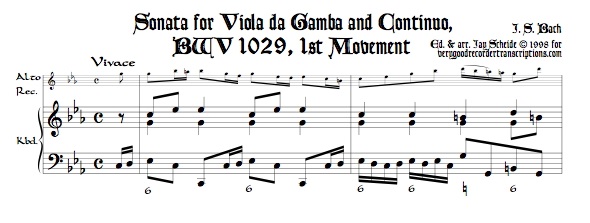Sonata No. 3 for Viola da Gamba and Continuo, BWV 1029, transposed to c
from: J.S. Bach - Chamber Music - Miscellaneous
Originally in g minor, transposed here to c. This arrangement has a precedent of sorts by Bach himself, in that Sonata No. 1 for Gamba, BWV 1027 seems to have originated as BWV 1039, a trio sonata for two flutes. Thus, the convertibility of music in different octaves and for different timbres (as well the number of instruments deployed) is clearly established in the repertory, even without reference to all the firm evidence we have about Baroque performance practice. In the first movement, some of the hardest passages for the recorder part are eliminated, or rather given to the keyboard player, simply by switching places between the original gamba part and the right hand of the keyboard part. Of course, the fact that these two parts are in the same style (very much as in a trio sonata, or a double concerto) is what makes this an especially viable transcriptional option. Note the alternative version in d; this one in c is a little bit more difficult. Film buffs take note that the slow movement of this sonata is featured prominently in the opening section of the 1991 movie "Truly, Madly, Deeply."
Keyboard parts include separate recorder parts at no additional cost.
Bach Sonata BWV 1029, transposed to c minor
20+5 pp.
$1.00

